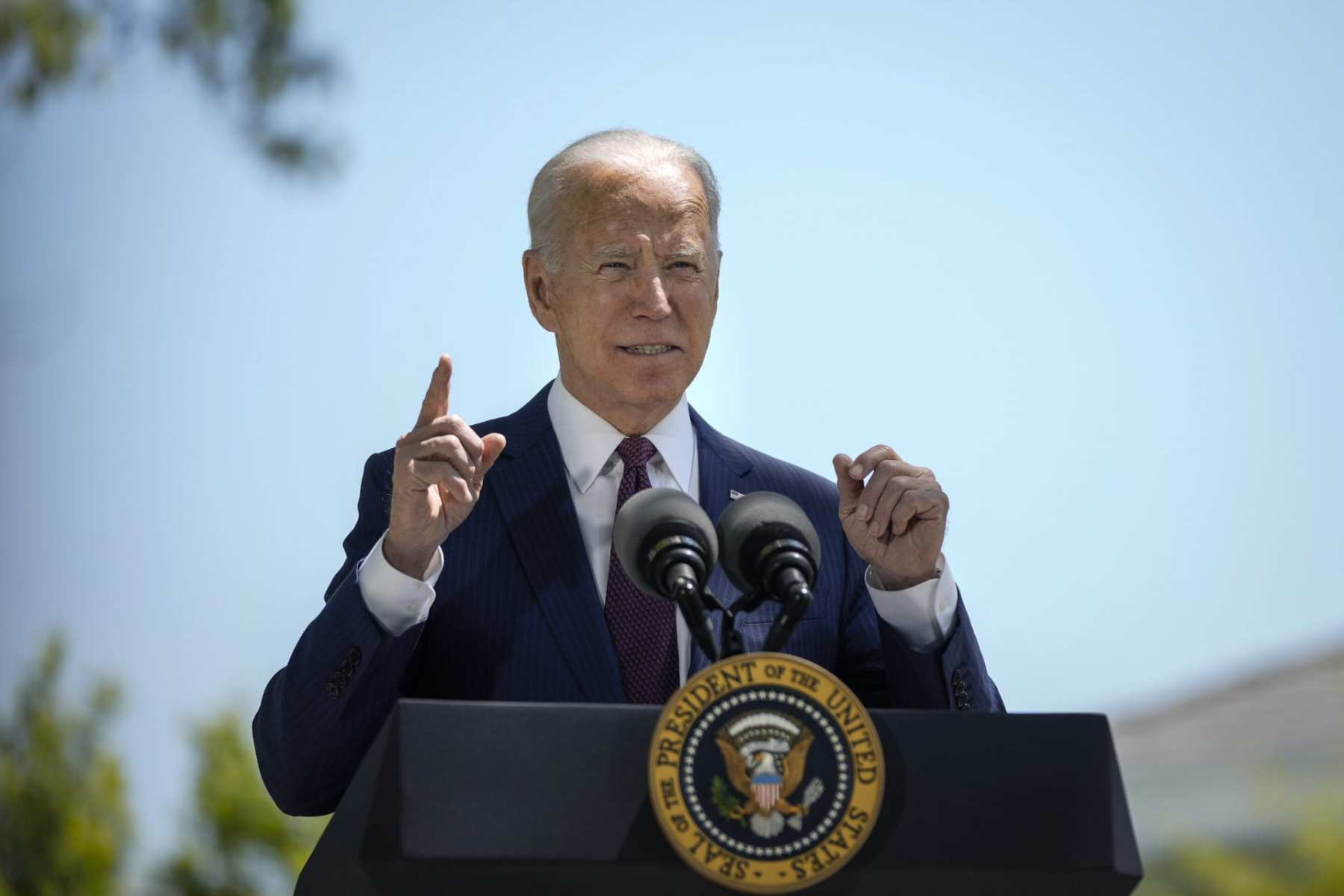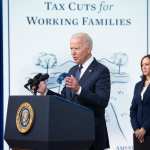Be the first to read our 100 days coverage. Subscribe to our newsletter today.
If passed, they would all be historic investments: hundreds of billions of dollars to revive the child care industry, a plan to create America’s first universal paid family and medical leave policy, and a path toward universal pre-kindergarten.
Each of those pillars of President Joe Biden’s American Families Plan, which he is set to outline in his first address to a joint session of Congress on Wednesday evening, is aimed at working women most of all. The new $1.8 trillion plan is the latest package proposed by the Biden administration, designed to shore up existing investments in children, families, and low- and middle-class workers while also building out new programs over a decade that would address long-standing Democratic priorities.
The policies are in part a response to the first women’s recession, which erased decades of progress for women in the labor force, triggered historically high rates of unemployment for women of color and pushed hundreds of thousands of working mothers out of their jobs. Much of that was driven by breakdowns in child care.
“I don’t think we can underestimate what this pandemic has done for this issue. Whether you have a child of your own, whether you were on Zoom with a co-worker who had a child — whoever it may be, you could not go anywhere in the past year without coming into the reality of what it means,” said Sarah Rittling, the executive director of the First Five Years Fund, a child care advocacy organization. “It’s one thing for an advocate to say, ‘We really need this.’ It’s an entirely different thing to have the president of the United States get up and speak in a joint address to Congress and put it on the table.”
The American Families Plan is the third major package from the Biden administration. The American Rescue Plan, Biden’s $1.9 trillion pandemic relief package that passed in March, laid some of the groundwork by expanding the child tax credit to the poorest families, investing nearly $40 billion in child care — at that point the largest investment in American history — and offering a tax credit for businesses that offer paid leave, considered at the time a step toward a universal plan. The president’s subsequent $2.3 trillion American Jobs Plan, which has not yet moved in Congress, is focused on infrastructure investments and also includes a $400 billion investment in care infrastructure to expand Medicaid payments and enhance pay and benefits for home health workers.
The American Families Plan is designed to build on those elements, making some of the tax cuts for families permanent and introducing policies, like universal paid leave and universal preschool, that most other industrialized countries already have.
The plan would be phased in over a 10-year period, with some elements being introduced immediately and others, like the paid leave policy, over time. The administration estimates that the investments will be fully paid for in 15 years, in part through hikes on the wealthiest Americans. The most significant of those would be raising the highest tax rate for the top 1 percent of earners to 39.6 percent from 37 percent, erasing the tax cut introduced in 2017 by then-President Donald Trump.
The plan faces sharp opposition from Republicans, even more so than the current resistance already brewing over the infrastructure package, particularly because it involves a tax hike. Not a single Republican voted in favor of Biden’s first major package, and the president faces slim margins in the House and Senate to push through his next two spending bills.
There’s also likely to be some pushback from within the president’s party. A group of prominent Democrats this week called on Biden to make permanent the one-year expansion of the child tax credit, considered by many the most significant piece of the American Rescue Plan.
That expansion made the credit available to the poorest families, who previously couldn’t access the full amount, and increased the funds available from $2,000 to $3,600 a year for the youngest children. That expansion is one of the largest anti-poverty measures the country has undertaken and could benefit nearly 66 million children, the administration estimated.
Facing significant pressure from Democrats, Biden is proposing that the element of the child tax credit that makes it available to the lowest-income families would become permanent through the American Families Plan, but the increased amount would be in effect through only 2025.
Some Democrats want to see all of the changes become permanent, including Rep. Rosa DeLauro of Connecticut, who has been championing the plan for nearly two decades, and Sens. Michael Bennet of Colorado, Sherrod Brown of Ohio and Cory Booker of New Jersey. They would not say whether that piece would make them vote against the legislation.
“My parents told me very early that everything was negotiable — except for [their] children,” Booker said during a press call to advocate for a permanent expansion this week. “We as a country should have the same attitude. I don’t mind having negotiations over bridges and tunnels and corporate tax cuts. But why are we gonna let our children and their wellbeing be a part of a negotiation in a few years?”
Here are the other major elements Biden is proposing in his plan:
Child care
At the start of the pandemic, the child care industry lost 1 in 3 workers, and only about half of those losses have been made up. The disruption in child care was a key driver that pushed hundreds of thousands of moms, especially, out of the labor force in the past year.
Even before the pandemic, about half of all Americans lived in child care deserts where there was 1 spot for every 3 children, according to the First Five Years Fund.. In 33 states and Washington, D.C., the annual cost of child care exceeded the average cost of in-state college tuition.
Biden’s plan would invest $225 billion in the industry, an infusion far surpassing the nearly $40 billion in the American Rescue Plan.
Under Biden’s proposal, the lowest-income families wouldn’t pay anything in child care costs, and those earning up to 150 percent of their state’s median income would be capped at paying no more than 7 percent of their income on child care. The administration estimates that the average family would save about $14,800 a year on child care expenses.
Currently states often have more children eligible for aid than they can serve, a problem the funds would help fix.
“Right now in America, we’re only serving 1 out of every 7 subsidy-eligible children. And so what we’re looking at in the American Families Plan is not just an expansion of who’s eligible for that affordable care, but we’re actually moving to a world where we will be providing it to the other six kids,” said Laura Dallas McSorley, the director of early childhood policy at the Center for American Progress, a liberal think tank.
The plan would also build on prior investments to return the supply in the child care industry to where it was before the pandemic. Access and affordability is one piece, but there’s also a need for centers that are open and available to take children.
The American Rescue Plan that already passed carved out $25 billion to stabilize the industry. The more recent American Jobs Plan proposes $25 billion to upgrade child care facilities and build more facilities through grants to states, with a focus on building centers in high-need areas.
The other part of building up access to quality care is investing in the workforce. Child care workers, who are 90 percent women and 40 percent women of color, would also see their wages rise to $15 an hour, with opportunities for job training and professional development, as part of Biden’s plan.
Low pay and little room for advancement are contributors to massive turnover rates in child care — as high as 40 percent in some states. Child care workers are some of the lowest-paid employees in the country, earning a median hourly wage of $12.24, lower than that of housekeepers and retail sales workers.
Khadijaa Lewis Khan, the executive director of the Beautiful Beginnings Child Care Center in Rhode Island, testified before Congress this week that it is difficult to find and retain qualified instructors under the current model.
“Child care is facing the most significant staffing challenges we’ve had,” Khan said. “Educators leave the field for higher-paying jobs, [with some] not only leaving the field but having to make the decision of whether to enter the field in the first place when some high school graduates earn more than them in entry-level positions in different industries.”
Building in aid for workers sends a signal about a commitment to the entire care infrastructure, said Julie Kashen, a senior fellow and director for women’s economic justice at the Century Foundation.
“Calling it the families plan — it’s a jobs plan,” Kashen said. “Care jobs are the jobs that are here to say. They cannot be outsourced, they cannot be automated. People would talk about the future of work for a long time — the future of work is care.”
Because of the scope of the need, other Democrats think Biden should go further. A plan led by Sen. Elizabeth Warren announced last week would invest $700 billion toward a universal child care program in the next decade. Another, from Sen. Patty Murray, plans to invest $600 billion in 10 years. Both plans also propose that families spend no more than 7 percent of their income on child care.
Kashen said the investment in the Biden plan sets needed groundwork for investing in child care in a way the country has not yet done.
“We are in a situation where Democrats have a very slim majority, and anything that passes is going to have to have a wide array of support from across the Democratic caucus, and hopefully maybe even from Republicans,” Kashen said. “We need to think about how we begin to build what we want to build.”
Universal paid family and medical leave
The administration is proposing investing $225 billion in universal paid parental, family and personal illness leave that will phase in over a decade until it hits 12 weeks. The plan would also offer all workers three days of paid bereavement leave a year, a change that will be enacted in the first year of the policy.
Still, workers would get partial pay — not full pay — for the time off and it will be on a sliding scale, with the government offering workers up to $4,000 a month in leave reimbursements. At least two-thirds of average weekly wages would be replaced, the administration said, and the lowest-wage workers would get up to 80 percent of their full wages paid when they take leave.
Currently, 80 percent of workers do not have paid family leave through an employer to care for a new child or sick loved one, according to the National Partnership for Women and Families.
Questions remain about how the White House plans to roll out the program and how much room there is to build off this initial proposal, said Lelaine Bigelow, the managing director of external affairs at the National Partnership for Women & Families, which has been advocating for paid leave for 28 years.
“It’s a great opening to start the negotiations for the phase-in. As we look at this more closely, as we work with Congress, I am going to hope that the phase-in period comes down a bit and we’ll get to a better and more accurate figure,” Bigelow said. “Because we’ve never had a national paid leave program implemented on this scale, I don’t think there really is a great sense of what the actual uptake is across the country on a national scale.”
The policy is popular among voters and small businesses that are looking to retain workers but need the aid of a federal program to manage the costs of offering the benefit.
About 95 percent of the lowest-paid workers in the country — predominantly women and particularly women of color — have no access to paid family leave. About 67 percent of those workers don’t get paid sick leave. In the pandemic, paid leave policies were proven to curb the spread of the virus, giving low-wage workers who depend on their paychecks to stay afloat the option to stay home instead of go to work when they had symptoms.
For women, access to family leave improves health and economic outcomes for them and their children and access to sick leave helps tether them to the workforce, giving flexibility to serve as caregivers for children or family members without the threat of losing employment.
“When you have paid family and medical leave and you offer more than just parental, you will see more men take leave. That is critical to having employers see men and women as equals in the workplace,” Bigelow said. “If men are able to take their own medical leave and take care of the older parent, then it is a gender-neutral policy — eventually.”
Free preschool and community college
The American Families Plan would make key investments in education that start at preschool and continue through higher education.
About $200 billion would go into creating a universal pre-kindergarten program for 3- and 4-year-olds, one of the policies Biden has been touting since the campaign trail. That program is expected to benefit 5 million children and save the average family $13,000 a year, the administration said.
All workers in the universal pre-K program would receive starting wages of $15 an hour, — the median wage is currently $15.35 an hour — and those who are qualified would be brought up to rates comparable with kindergarten teachers.
For students in higher education, the Families Plan devotes $109 billion to offer two years of free community college for first-time students or workers who want to develop another skill. The benefit would be accessible over as long as four years for those who couldn’t attend school full-time.
Both the pre-K and community college programs would be in partnership with states, which could opt out if they wish. In that case, the senior administration officials said, they would look to partner with localities or institutions to provide access to the programs. The contribution from states for the pre-K piece would be 10 percent at first and then phase up to 50 percent. For community colleges, when the program is fully implemented, states would pay 25 percent and the federal government would pay 75 percent of the cost.
Many states already support expanded preschool options, including states led by Republican governors including Georgia, Alabama and Oklahoma.
More aid in Biden’s plan is also slated to enhance the Pell Grant program for the neediest students ($85 billion) and programs to strengthen retention and completion rates at colleges and universities that serve many low-income students and students of color ($62 billion) and to create a new program to offer two years of subsidized tuition for students in families earning less than $125,000 a year who enroll in historically Black colleges and universities, tribal colleges and universities, and other minority-serving institutions ($39 billion).
An additional $9 billion would go into strengthening the teacher workforce — a field that is nearly 75 percent women — with enhanced scholarships for future educators, funding for teacher leadership and mentorship programs, and support for teachers who want to obtain additional certifications.
Taken together, the investments in care across age groups and access to leave could help ensure parity for women, said McSorley of the Center for American Progress.
“As we think about extending that highly affordable, accessible and readily available care for babies, toddlers and preschoolers, we know it’ll enable mothers, in particular, to make choices about their workforce participation and their families’ economic security that are far more expansive than they are able to do right now,” she said. “When we think about that on scale, that’s where we start to see the path towards a gender-equitable recovery.”






